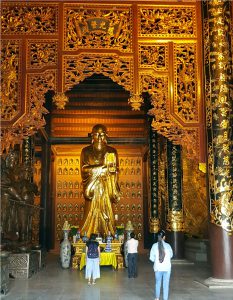Zen Buddhism’s Allure in
Vietnam’s Most Storied Pagodas
Introduction
With Mahayana Buddhism serving as the dominant strand in Vietnam, Zen teachings have captivated scholars and monks for centuries through its enigmatic koans and meditation. While Zen (Thiền in Vietnamese) never established a separate school here unlike China or Japan, its imprint emerges in the spiritual life, architecture and lore of Vietnam’s most acclaimed pagodas. These temples narrate the subtle yet lasting influence of Zen in Vietnamese Buddhism.
Tran Quoc Pagoda: The Earliest Zen Haven
Founded in the 6th century on a small peninsula in Hanoi’s West Lake,
Tran Quoc Pagoda is possibly Vietnam’s oldest temple. With its gleaming red-lacquered pillars, triple gateways and well-kept gardens, the petite but atmospheric pagoda exudes a peaceful aura. Its layout follows feng shui principles with a mountain vista to the north and West Lake vistas towards the east, evoking Zen aesthetics.

While legend credits the temple’s site selection to a Bodhisattva, some records indicate Indian monk Gunavarman introduced Zen meditation here. Its Abbott in the 15th century, An Thuong, produced commentaries on eminent Zen koan cases. Through the centuries, Tran Quoc has endured as Hanoi’s purest Zen sanctuary.
One Pillar Pagoda: Temple of Simplicity
Built in 1049 by Emperor Ly Thai Tong who ruled from nearby Imperial Citadel, Hanoi’s iconic
One Pillar Pagoda visually epitomizes Zen minimalism with its tiny single-pillar structure set amidst tranquil water gardens. While visually reminiscent of Chinese pavilions, a solid square stone base reflects Vietnamese architectural logic.
Its lotus-shaped concrete pillar both symbolizes purity and lifts the shrine above floodwaters. Inside, offerings to Quan Am rest beneath a wooden Amitabha Buddha statue. One Pillar Pagoda demonstrates Zen’s light touch – conveying sublime insight through simplicity.

Perfume Pagoda: Pilgrim’s Gateway to Serenity
Fragrant plants like ‘huong” (perfume) creepers after which this cave temple complex northwest of Hanoi is named. Which seemed to emit sweet scents setting the mood for a spiritual journey. Visitors must ride smaller dragon boats along scenic waterways lined by limestone cliffs towards the site. On arrival, walking through semi-dark cavern tunnels with makeshift lights provokes deep reflection.
Finally, a magnificent vista overlooking smaller peaks covered in tropical vegetation reveals itself – marking the climax where Perfume Temple is reached either via steps or a cable car. This sublime setting has attracted ascetic monks and hermits for centuries, making it Vietnam’s most famous pilgrimage site to experience Zen wonder.
Bai Dinh Pagoda: Home of the Zen Master of Yesteryear
Bai Dinh Pagoda in Ninh Binh province houses Vietnam’s largest Buddha statue in its majestic new concrete complex. Surrounding this ultra-modern construction with lavish donations, one finds the original ancient Bai Dinh temple in rocky caves where legendary 13th century Zen adept, Tu Dao Hanh, had his hermitage.

Wooden columns covered by inscriptions with Zen poems and paradoxical metaphors mark Tu Dao Hanh’s thatched hut. Nearby placards describe his eccentric antics like burning a wooden statue of revered monk Xuan Hai for disciples to warm themselves. Clear springs emerging from stone form decorative pools. Though nestled inconspicuously behind the grand new Bai Dinh, Tu Dao Hanh’s modest abode represents Vietnam’s historic Zen lineages.
Conclusion
Vietnamese Buddhism absorbed subtle Zen influences through monks traveling to study in China. These are Chinese master’s teachings, and hybrid architecture in pagodas where prince-turned-monks sponsored construction. While Thiền never established separate institutions, Zen Buddhism aesthetics reveal themselves in Vietnam’s ancient temples. Whether it demonstrates through minimalist structures by West Lake or dramatic caverns filled with incense. These sacred sites continue drawing spiritual seekers and mindfulness practitioners.
If you are in Vietnam and interested in discovering more about Hanoi – the capital and its significance, we invite you to join us at
Free Walking Tours Hanoi. We’ll take you across the building, and provide you with a unique perspective of the city.
Book now and don’t miss out on this amazing experience.



